B0041VYHGW EBOK (68 page)
Authors: David Bordwell,Kristin Thompson

After filming, the filmmaker can still control the speed of movement on the screen through various laboratory procedures. Until the early 1990s, the most common means used was the optical printer. This device rephotographs a film, copying all or part of each original frame onto another reel of film. The filmmaker can use the optical printer to skip frames (accelerating the action when projected), reprint a frame at desired intervals (slowing the action by
stretch printing
), stop the action (repeating a frame over and over, to freeze the projected image for seconds or minutes), or reverse the action. Some silent films are stretch-printed with every other frame repeated, so that they may run more smoothly at sound speed. We are familiar with freeze-framing, slow-motion, and reverse-motion printing effects from the
instant replays
of sports coverage and investigative documentaries. Many experimental films have made striking use of the optical printer’s possibilities, such as Ken Jacobs’s
Tom Tom the Piper’s Son,
which explores the images of an early silent film by enlarging portions of its shots. Today the optical printer has largely been replaced by digital manipulations of the speed of movement.
You are standing on railroad tracks, looking toward the horizon. The tracks not only recede but also seem to meet at the horizon. You glance at the trees and buildings along the tracks. They diminish by simple, systematic rule: the closer objects look larger, the farther objects look smaller—even if they are actually of uniform size. The optical system of your eye, registering light rays reflected from the scene, supplies a host of information about scale, depth, and spatial relations among parts of the scene. Such relations are called
perspective
relations.
The
lens
of a photographic camera does roughly what your eye does. It gathers light from the scene and transmits that light onto the flat surface of the film to form an image that represents size, depth, and other dimensions of the scene. One difference between the eye and the camera, though, is that photographic lenses may be changed, and each type of lens will render perspective in different ways. If two different lenses photograph the same scene, the perspective relations in the resulting images could be drastically different. A wide-angle lens could exaggerate the depth you see down the track or could make the foreground trees and buildings seem to bulge; a telephoto lens could drastically reduce the depth, making the trees seem very close together and nearly the same size.
Control of perspective in the image is very important to the filmmaker. The chief variable in the process is the
focal length
of the lens. In technical terms, the focal length is the distance from the center of the lens to the point where light rays converge to a point of focus on the film. The focal length alters the perceived magnification, depth, and scale of things in the image. We usually distinguish three sorts of lenses on the basis of their effects on perspective:
1.
The short-focal-length
(wide-angle)
lens
In 35mm-gauge cinematography, a lens of less than 35mm in focal length is considered a wide-angle lens. Such lenses tend to distort straight lines lying near the edges of the frame, bulging them outward. Note the distortion in two frames from a shot in Nicholas Roeg’s
Don’t Look Now
(
5.19
,
5.20
).
When a wide-angle lens is used for a medium shot or close-up, the distortion of shape may become very evident
(
5.21
).
The lens of short focal length has the property of exaggerating depth
(
5.22
).
Because distances between foreground and background seem greater, the wide-angle lens also makes figures moving to or from the camera seem to cover ground more rapidly.
2.
The middle-focal-length
(medium)
lens
A common lens length for a medium lens is 50mm. This lens seeks to avoid noticeable perspective distortion. With a medium lens, horizontal and vertical lines are rendered as straight and perpendicular. (Compare the bulging effect of the wide-angle lens.) Parallel lines should recede to distant vanishing points, as in our railroad tracks example. Foreground and background should seem neither stretched apart (as with the wide-angle lens) nor squashed together (as with the telephoto lens). A medium lens was used for
5.23
; contrast the sense of distance among the figures achieved in
5.22
.
3.
The long-focal-length
(telephoto) lens
Whereas wide-angle lenses distort space laterally, longer lenses flatten the space along the camera axis. Cues for depth and volume are reduced. The planes seem squashed together, much as when you look through a telescope or binoculars. In
5.24
, from Chen Kaige’s
Life on a String,
the long lens pushes the crowd members almost to the same plane. It also makes the rapids behind the men virtually a two-dimensional backdrop.
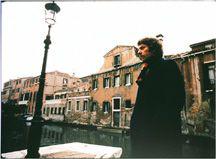
5.19 In
Don’t Look Now,
as the camera swivels to follow the walking character, the wide-angle lens makes a street lamp he passes appear to lean rightward …
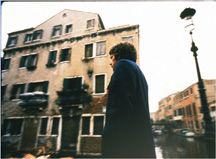
5.20 … and then leftward.
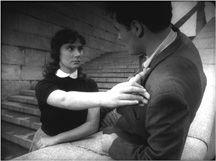
5.21 Wide-angle distortion in Mikhail Kalatozov’s
The Cranes Are Flying.
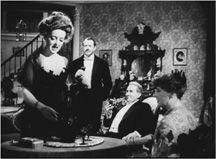
5.22 In this scene from
The Little Foxes,
the lens makes the characters seem farther from one another than we would expect in so relatively tight a grouping.
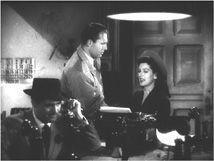
5.23 A shot made with a medium lens in
His Girl Friday.
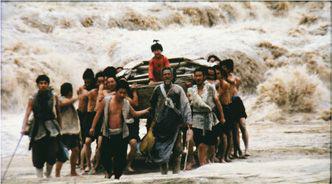
5.24 The long lens in Chen Kaige’s
Life on a String.
“I’m standing around waiting to see where the 50mm is going to be, or what size lens they’re putting on, and in that unwritten book in my brain, I said, ‘Don’t ever let them shoot you full face, on a wide-angle lens, you’ll end up looking like Dumbo.’”
— Tony Curtis, actor
“In
New York, New York,
we shot only with a 32mm lens, the whole movie. We tried to equate the old style of framing, the old style meaning 1946–53.”— Martin Scorsese, director
Today long lenses typically are 100mm or greater in length. They are commonly used in the filming or televising of sports events, since they allow the cinematographer to magnify action at a distance. (For this reason, long lenses are also called telephoto lenses.) In a baseball game, there will invariably be shots taken from almost directly behind the pitcher, using a camera located beyond the center field wall. You have probably noticed that such shots make the umpire, catcher, batter, and pitcher look unnaturally close to one another. What a very long lens can do to space is dramatically illustrated throughout Godfrey Reggio’s
Koyaanisqatsi
(
5.25
).
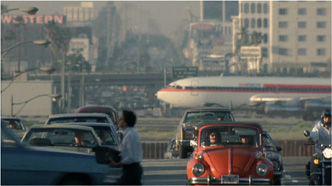
5.25 In
Koyaanisqatsi,
an airport is filmed from a great distance, and the long lens makes it appear that a plane is landing on a crowded highway.
